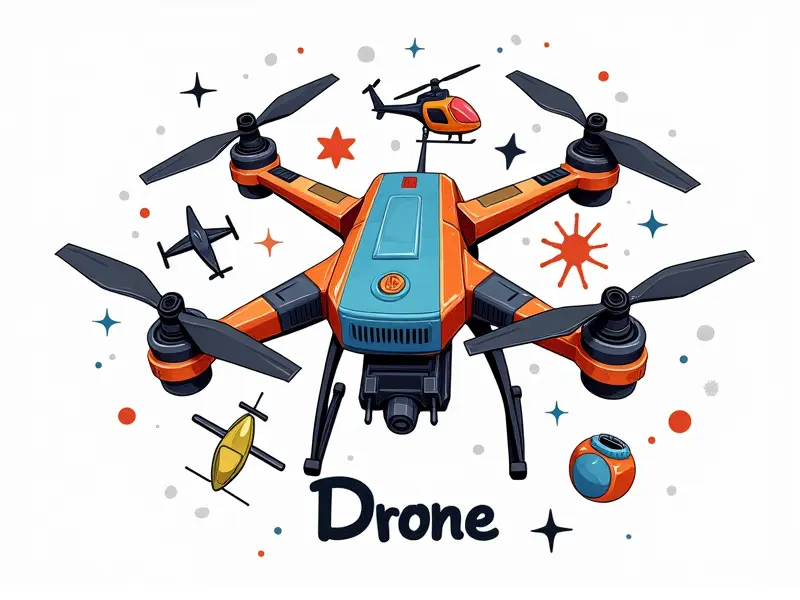How do drone batteries work?

Drones have become an integral part of our lives, from aerial photography to delivery services. However, the performance and longevity of these flying machines heavily rely on their battery technology. Understanding how drone batteries work is crucial for both enthusiasts and professionals alike.
Inside Drone Battery Technology
The heart of any drone's operation lies in its battery system. Modern drones predominantly use lithium-polymer (LiPo) batteries due to their high energy density, lightweight nature, and ability to provide sustained power during flight operations. Inside a LiPo battery, you'll find layers of anode and cathode materials separated by a porous separator soaked with electrolyte.
Understanding Drone Power Sources
The choice of power source significantly impacts the drone's performance. Lithium-polymer batteries are favored for their superior energy-to-weight ratio compared to other battery types like nickel-cadmium (NiCd) or nickel-metal hydride (NiMH). This makes them ideal for drones that require long flight times and efficient weight management.
Types of Drone Batteries 101
Besides LiPo batteries, there are other types available in the market. However, LiPo remains the most popular due to its reliability and performance. Other options include lithium-ion (Li-Ion) and nickel-based batteries, but they offer less energy density and shorter lifespans.
How Lithium-Polymer Powers Drones
Lithium-polymer batteries power drones through a series of chemical reactions that convert stored chemical energy into electrical energy. During discharge, lithium ions move from the anode to the cathode through the electrolyte and separator, generating electricity.
Electrochemical Reactions in LiPo Batteries
- Anode: Lithium ions are released during charging.
- Cathode: Lithium ions are absorbed during discharging.
- Separator: Prevents direct contact between anode and cathode, allowing ion transfer.
Maximizing Your Drone's Battery
To get the most out of your drone’s battery, it is essential to follow best practices. This includes maintaining optimal charge levels, avoiding overcharging or deep discharging, and storing batteries at room temperature when not in use.
Tips for Maximizing LiPo Batteries
- Charge between 3.7V and 4.2V per cell.
- Avoid letting the battery drop below 3.0V per cell.
- Store batteries at around 50% charge level for long-term storage.
Battery Life in Drones Revealed
The lifespan of a drone's battery is influenced by several factors, including the number of charging cycles and environmental conditions. Typically, LiPo batteries can last up to 300-500 charge cycles before their capacity starts to degrade.
Factors Affecting Battery Lifespan
- Temperature: Extreme heat or cold can reduce battery life.
- Usage Patterns: Frequent deep discharges shorten lifespan.
- Maintenance: Proper care and handling extend battery longevity.
The Science of Drone Charging
Charging a drone's LiPo battery involves careful management to prevent damage. Use chargers designed specifically for LiPo batteries, as they provide the correct charging protocol (Constant Current Constant Voltage) necessary to maintain optimal performance and safety.
Safe Charging Practices
- Balancing: Ensure all cells are charged evenly.
- Monitoring: Keep an eye on temperature during charging.
- Storage: Store batteries in a fireproof container when not in use.
Unveiling Drone Battery Secrets
Beyond the basics, there are several advanced techniques to optimize drone battery performance. These include using high-quality chargers, implementing temperature management systems, and employing smart battery monitoring technologies that provide real-time data on battery health.
Advanced Techniques
- Temperature Control: Use cooling pads or fans during charging.
- Battery Management Systems (BMS): Monitor and regulate voltage levels.
- Data Analytics: Analyze battery performance data for predictive maintenance.
Decoding Drone Battery Technology
The technology behind drone batteries is constantly evolving. Innovations such as solid-state batteries, which promise higher energy density and improved safety, are on the horizon. Understanding these advancements can help you stay ahead in the rapidly changing world of drones.
Innovative Trends
- Solid-State Batteries: Offer better performance and safety.
- Battery Swapping Systems: Enable quick replacement during operations.
- Wireless Charging: Eliminate the need for physical connectors.
Optimizing Battery Performance in Drones
To optimize battery performance, focus on regular maintenance and proper usage. Regularly inspect batteries for signs of wear or damage, and follow manufacturer guidelines for charging and discharging cycles. Additionally, consider upgrading to the latest battery technology as it becomes available.
Maintenance Tips
- Visual Inspection: Look for swelling, leaks, or cracks.
- Cleaning: Remove dust and debris from connectors.
- Testing: Use a multimeter to check voltage levels.
Secrets of Efficient Drone Batteries
The key to efficient drone batteries lies in understanding the nuances of battery chemistry, proper charging techniques, and advanced maintenance practices. By staying informed about these aspects, you can ensure your drone operates at peak performance throughout its lifespan.
Efficiency Tips
- Educate Yourself: Stay updated with the latest battery technology trends.
- Invest in Quality: Choose reputable brands for batteries and chargers.
- Experiment: Test different configurations to find optimal settings.
Conclusion
In conclusion, understanding how drone batteries work is essential for maximizing the performance of your flying machine. By delving into the intricacies of LiPo technology, adopting best practices for charging and maintenance, and staying informed about emerging trends, you can ensure that your drone operates efficiently and safely.

